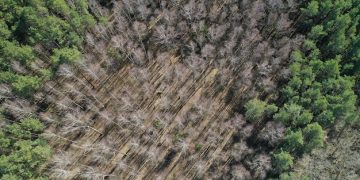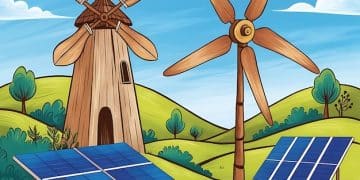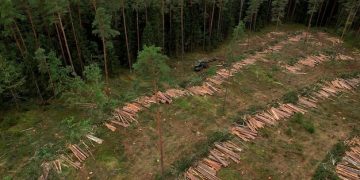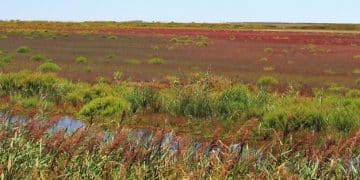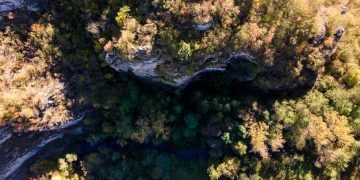Unveiling the Economic Benefits of Wildlife Conservation
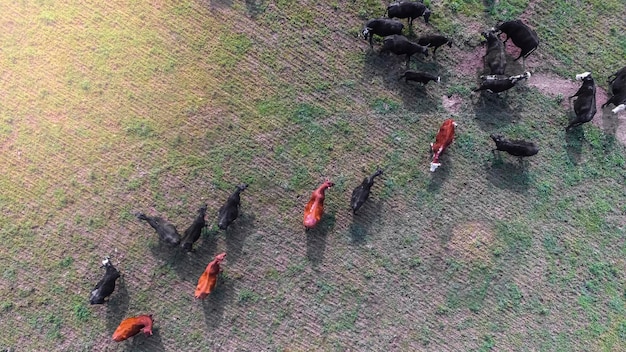
The Economic Benefits of Wildlife Conservation: How Protecting Nature Drives Tourism and Recreation reveals the significant financial advantages that arise from preserving wildlife, highlighting its positive impact on tourism, recreation, and overall economic growth.
Dive into the unexpected world of the economic benefits of wildlife conservation: how protecting nature drives tourism and recreation. Beyond the intrinsic value of preserving our planet’s biodiversity, there are compelling financial advantages to protecting wildlife and their habitats.
Understanding the Economic Value of Wildlife
The economic value of wildlife extends far beyond mere aesthetics; it is intricately linked to vital sectors such as tourism, recreation, and scientific research. By acknowledging and leveraging these economic benefits, we can create more sustainable and effective approaches to conservation.
Wildlife Tourism: A Key Economic Driver
Wildlife tourism, a significant subset of ecotourism, involves traveling to observe animals in their natural habitats. This industry generates substantial revenue, supporting local economies and providing incentives for conservation.
Recreational Activities and Wildlife
Many recreational activities, such as hiking, fishing, and birdwatching, depend directly on healthy wildlife populations and intact ecosystems. These activities contribute to local economies through the sale of equipment, permits, and related services.
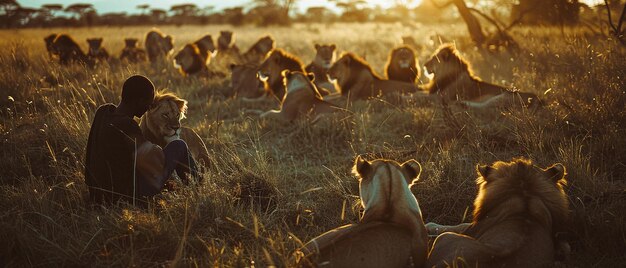
Here are some points that showcase the economic value:
- Direct Revenue: Tourism dollars spent on lodging, food, and transportation.
- Job Creation: Opportunities in guiding, hospitality, and park management.
- Conservation Funding: Revenue channeled back into protecting wildlife habitats.
Therefore, the economic value of wildlife is a powerful tool for promoting conservation. It provides a strong argument for investing in the protection of natural habitats and the species that inhabit them.
The Role of Conservation in Boosting Tourism
Effective wildlife conservation efforts play a pivotal role in boosting the tourism industry. When wildlife habitats are well-protected and managed, they become attractive destinations for tourists eager to experience nature and observe animals in their native environments.
Attracting International and Domestic Tourists
Well-conserved wildlife areas draw visitors from around the globe, injecting significant revenue into local and national economies. Domestic tourists, too, are increasingly seeking out nature-based experiences, further contributing to the economic benefits.
Case Studies: Successful Tourism-Driven Conservation
Numerous case studies demonstrate the effectiveness of tourism-driven conservation. For example, national parks in Africa generate millions of dollars annually, supporting both wildlife protection and community development. In Costa Rica, ecotourism focused on rainforests and wildlife has become a major economic driver, demonstrating the power of sustainable tourism.
Here are some key ingredients for success:
- Community Involvement: Engaging local communities in conservation efforts.
- Sustainable Practices: Implementing eco-friendly tourism operations.
- Effective Marketing: Promoting wildlife areas as premier tourist destinations.
In essence, conservation efforts act as a catalyst, transforming wildlife areas into economic engines that benefit both nature and people.
Supporting Local Economies Through Wildlife Recreation
Wildlife recreation is a cornerstone of local economies in many regions, providing a diverse range of opportunities for both residents and visitors. Activities such as hunting, fishing, and wildlife viewing generate revenue and support jobs in rural communities.
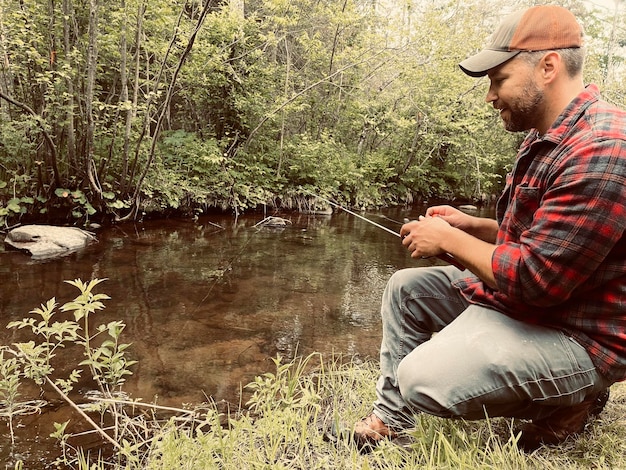
Hunting and Fishing: Revenue Generators
Hunting and fishing licenses, along with excise taxes on related equipment, contribute significant funds to state and federal conservation agencies. This revenue is often used to manage wildlife populations and restore habitats.
Wildlife Viewing and Photography
Wildlife viewing and photography are becoming increasingly popular forms of recreation, attracting nature enthusiasts who spend money on travel, lodging, and equipment. This influx of revenue supports local businesses and promotes conservation awareness.
To maximize the economic benefits, consider the following ideas:
- Promote Sustainable Practices: Encourage responsible recreation that minimizes impact on wildlife.
- Invest in Infrastructure: Improve trails, visitor centers, and other facilities to enhance the recreation experience.
- Educate Visitors: Raise awareness about the importance of conservation and responsible behavior.
By nurturing wildlife recreation opportunities, communities can unlock a powerful engine for economic growth and environmental stewardship.
Quantifying the Economic Impact: Data and Statistics
Quantifying the economic impact of wildlife conservation involves collecting and analyzing data to demonstrate the tangible benefits. By measuring the economic contributions of tourism, recreation, and other wildlife-related activities, we can make a compelling case for conservation investments.
Measuring Tourism Revenue and Job Creation
Tourism revenue can be tracked through hotel occupancy rates, visitor spending surveys, and entrance fees to wildlife areas. Job creation can be assessed by counting employment in tourism-related sectors, such as guiding, hospitality, and park management. The U.S. Fish and Wildlife Service estimates that wildlife-related recreation generates billions of dollars annually and supports hundreds of thousands of jobs.
Assessing the Value of Ecosystem Services
Ecosystem services, such as pollination, water purification, and carbon sequestration, are essential for human well-being and economic prosperity. Estimating the economic value of these services can demonstrate the broader benefits of wildlife conservation. For example, the economic value of pollination by bees and other insects is estimated to be billions of dollars annually.
To strengthen conservation efforts, we need better data on different aspects, such as:
- Improved Data Collection: Enhance the accuracy and coverage of data on tourism, recreation, and ecosystem services.
- Economic Modeling: Develop models to predict the economic impacts of conservation policies.
- Cost-Benefit Analysis: Conduct thorough analyses to evaluate the economic benefits of conservation investments.
The data is essential for advocating for policies that promote both economic prosperity and environmental sustainability.
Success Stories: Conservation Projects that Boosted Local Economies
Examining successful conservation projects highlights how these initiatives can lead to significant economic benefits for local communities. These stories serve as models for future endeavors, showcasing the potential for conservation to drive sustainable development.
African National Parks: A Tourism Case Study
Many African national parks have transformed from conservation areas to major economic drivers. For example, the Serengeti National Park in Tanzania generates millions of dollars in tourism revenue each year, supporting thousands of jobs in local communities. This revenue is used to fund conservation efforts, combat poaching, and improve the livelihoods of local residents.
Costa Rica’s Ecotourism Model
Costa Rica has emerged as a global leader in ecotourism, leveraging its rich biodiversity to attract visitors from around the world. The country’s national parks and wildlife reserves generate significant revenue, supporting both conservation and community development. Costa Rica’s commitment to sustainable tourism practices has created a model for other nations to follow.
Key elements to success include:
- Community Ownership: Empower local communities to participate in and benefit from tourism.
- Sustainable Infrastructure: Invest in eco-friendly lodging and transportation options.
- Long-Term Planning: Develop long-term strategies that balance conservation with economic development.
By learning from these stories, we can replicate their success in other regions, creating a future where conservation and economic prosperity go hand in hand.
Overcoming Challenges: Balancing Conservation and Economic Development
Balancing conservation and economic development presents significant challenges. Often, there are conflicting interests between those seeking to protect wildlife and those pursuing economic opportunities. Overcoming these challenges requires innovative solutions and collaborative approaches.
Addressing Competing Interests
One of the main challenges is navigating the competing interests of different stakeholders. Developers might seek to build on ecologically sensitive land, while local communities may rely on natural resources for their livelihoods. Addressing these conflicts requires careful planning, stakeholder engagement, and the implementation of sustainable practices.
Mitigating Negative Impacts
Economic development projects can have negative impacts on wildlife habitats, such as habitat destruction, pollution, and disturbance of wildlife populations. To mitigate these impacts, environmental impact assessments should be conducted before any major development project is approved. Mitigation measures, such as habitat restoration and wildlife corridors, can help minimize the harm to wildlife.
Several ideas for working together are:
- Incentive Programs: Offer financial incentives for conservation, such as tax breaks for landowners who protect wildlife habitats.
- Ecotourism Initiatives: Develop ecotourism ventures that provide economic benefits to local communities while promoting conservation.
- Collaborative Partnerships: Foster partnerships between government agencies, conservation organizations, and the private sector.
It is all about ensuring long-term sustainability and shared prosperity.
The Future of Wildlife Conservation and Economic Growth
The future of wildlife conservation and economic growth is increasingly intertwined. As awareness of the economic benefits of wildlife conservation grows, there is a greater opportunity to integrate conservation into broader economic development strategies.
Integrating Conservation into Economic Planning
Integrating conservation into economic planning involves incorporating environmental considerations into all levels of decision-making. This means conducting environmental impact assessments before approving development projects, investing in sustainable infrastructure, and promoting eco-friendly tourism practices. It also requires developing policies that encourage conservation, such as tax incentives for landowners who protect wildlife habitats.
Embracing Sustainable Practices
Sustainable practices are essential for ensuring the long-term economic benefits of wildlife conservation. This includes promoting responsible tourism, minimizing pollution, and managing natural resources sustainably. It also involves investing in renewable energy and reducing greenhouse gas emissions to combat climate change, which poses a significant threat to wildlife habitats worldwide.
Key strategies include:
- Global Cooperation: Foster international agreements to protect migratory species and combat wildlife trafficking.
- Technological Innovation: Use technology to monitor wildlife populations, combat poaching, and promote sustainable tourism.
- Public Education: Raise awareness about the economic and ecological importance of wildlife conservation.
In conclusion, it is possible to achieve the economic benefits of wildlife conservation: how protecting nature drives tourism and recreation.
| Key Aspect | Brief Description |
|---|---|
| 🌍 Wildlife Tourism | Generates revenue, supporting local economies and conservation initiatives. |
| 🎣 Wildlife Recreation | Hunting, fishing, and wildlife viewing that generate revenue and support jobs. |
| 📊 Economic Data | Quantifying economic impact through tourism revenue, job creation, and ecosystem services. |
| 🤝 Collaboration | Balancing conservation & economic development with sustainable practices. |
Frequently Asked Questions
▼
Wildlife conservation boosts tourism revenue, supports recreational activities, and contributes to ecosystem services that benefit agriculture and water resources, thus fostering economic growth.
▼
Wildlife tourism creates jobs in hospitality, guiding, and transportation, generating revenue through tourist spending on lodging, food, and activities in local communities.
▼
Recreational activities like hunting, fishing, and birdwatching generate revenue through licenses, equipment sales, and related services, supporting local businesses and promoting conservation.
▼
Economic planning can integrate conservation through environmental impact assessments, eco-friendly tourism, sustainable infrastructure investments, and policies that incentivize wildlife habitat protection.
▼
Conflicts of interest, habitat destruction, and pollution pose significant challenges. Mitigation strategies include stakeholder engagement, impact assessments, and sustainable practices like ecotourism.
Conclusion
In conclusion, the economic benefits of wildlife conservation: how protecting nature drives tourism and recreation are substantial and diverse, offering significant opportunities for economic growth and sustainability. By integrating conservation into economic planning and embracing sustainable practices, we can create a future where both people and wildlife thrive.
